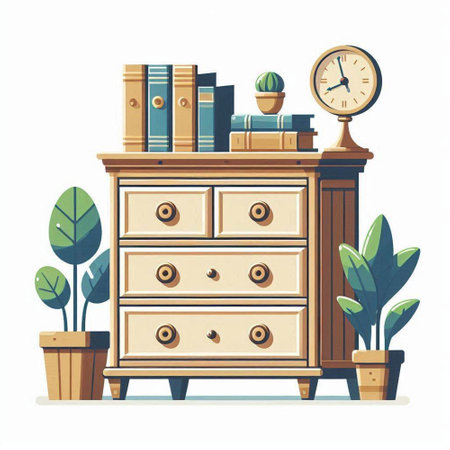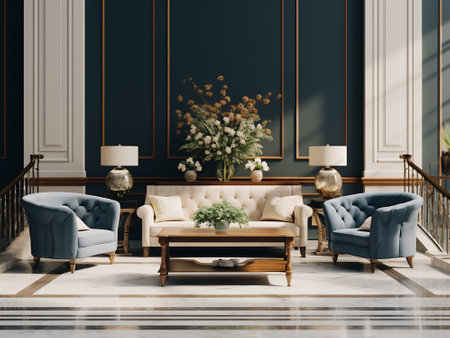Colonial Beginnings
Classic and traditional home decor in America finds its roots in the early days of the colonial period, when settlers brought both necessity and simplicity into their living spaces. Colonial design is celebrated for its emphasis on practicality, which is reflected in the straightforward woodworking techniques and sturdy, handcrafted furniture pieces that still inspire today’s classic interiors. These homes often featured functional built-ins, like cabinets and shelves, constructed from locally sourced woods such as pine or oak. The muted color palettes—think soft creams, earthy browns, and gentle blues—were directly inspired by what was available to settlers, aiming for durability and comfort over extravagance. This approach laid the groundwork for a timeless aesthetic that values understated elegance and craftsmanship, making colonial influences a cornerstone of traditional American home décor even centuries later.
Victorian Elegance
The Victorian era, spanning from the mid-19th century to the early 20th century, remains a defining influence on classic and traditional American home decor. This period is celebrated for its opulence and attention to detail, inspiring homeowners to incorporate luxurious elements into their living spaces. Intricate trims, ornate moldings, and elaborate ceiling medallions became hallmarks of the time, reflecting a love for decorative artistry and craftsmanship. The use of rich fabrics—such as velvet, brocade, and damask—added depth and texture to interiors, while heavy draperies provided both privacy and a sense of grandeur.
Decorative wallpapers were another signature of Victorian style, often featuring floral motifs, damask patterns, or even scenic landscapes. These wallpapers brought color and personality to parlors and dining rooms, setting a mood of refinement. Furniture during this era was characterized by its curved lines, carved wood details, and dark finishes, making each piece a statement in itself. Below is a quick overview of key Victorian elements that continue to inspire traditional American interiors:
Feature |
Description |
Modern Application |
|---|---|---|
| Ornate Trim & Moldings | Intricate woodwork around ceilings, doors, and windows | Adds architectural interest and elegance to rooms |
| Rich Fabrics | Velvet, brocade, damask used in upholstery and drapes | Brings warmth and luxury to sofas, curtains, or pillows |
| Decorative Wallpaper | Bold patterns with florals or historic scenes | Makes accent walls or powder rooms stand out |
| Curved & Carved Furniture | Sofas and chairs with ornate wood detailing | Creates a focal point in living or sitting areas |
The enduring appeal of Victorian elegance lies in its ability to blend drama with comfort. By integrating these historical inspirations—whether through subtle details like crown molding or bold statements like patterned wallpaper—you can evoke the timeless charm of the Victorian era within your own traditional American home.

3. Neoclassical Revival
Neoclassical design has long been celebrated in American homes for its refined elegance and historical depth. Drawing inspiration from the grandeur of ancient Greece and Rome, neoclassical motifs such as stately columns, symmetrical layouts, and classical ornamentation remain enduring favorites in traditional home décor. These elements create a sense of order and balance that feels both timeless and sophisticated, making them especially popular in formal living rooms, dining areas, and grand entryways.
The use of architectural features like pilasters, cornices, and decorative moldings channels the spirit of neoclassical architecture while adapting it to modern lifestyles. This style often incorporates neutral color palettes, marble or stone accents, and carefully curated furnishings that evoke a sense of history without feeling outdated. Americans appreciate how neoclassical revival can set an impressive yet welcoming tone—perfect for entertaining guests or cultivating a serene retreat at home.
By referencing classical antiquity, neoclassical décor not only pays homage to the past but also offers a way to infuse interiors with gravitas and formality. Whether through statement pieces like Grecian urns and Roman busts or through more subtle details such as fluted legs on furniture or geometric floor patterns, this style delivers a polished look that never goes out of fashion. The continued appeal of neoclassical motifs lies in their ability to bridge eras, offering homeowners a way to celebrate tradition while maintaining a fresh and inviting atmosphere.
4. Craftsman Influence
The American Arts and Crafts movement, which gained momentum in the late 19th and early 20th centuries, left a profound mark on classic and traditional home decor. This movement was a direct response to the mass-produced, overly ornate styles of the Victorian era. Instead, it embraced simplicity, quality craftsmanship, and natural materials—values that continue to shape American interiors today.
One of the most recognizable elements introduced by the Craftsman style is the use of built-in features. From bookcases flanking fireplaces to window seats and custom cabinetry, these thoughtful additions were designed for both function and beauty. Built-ins remain highly desirable in traditional homes because they maximize space while adding architectural interest.
Another hallmark of Craftsman influence is exposed woodwork. This includes visible beams, substantial trim, and handcrafted staircases, all highlighting the inherent beauty of wood grain. The emphasis on artisanal quality means that even everyday details like door frames or wainscoting receive careful attention, creating a sense of warmth and authenticity that resonates with American homeowners.
Key Elements of Craftsman Style in Traditional Decor
| Feature | Description |
|---|---|
| Built-In Furniture | Custom shelves, benches, cabinets integrated into architecture |
| Exposed Woodwork | Visible beams, trim, and detailed joinery |
| Natural Materials | Use of oak, maple, stone, and other organic elements |
| Handcrafted Details | Stained glass windows, artisan tilework, metal hardware |
This commitment to craftsmanship and honest materials not only laid the groundwork for the enduring appeal of traditional American homes but also established principles that are still relevant to anyone seeking timeless interior design.
5. European Roots
When it comes to classic and traditional home décor in America, the influence of European design traditions is undeniable. From the rustic warmth of French country homes to the stately elegance of English manor houses, these Old World styles have long inspired American tastes. Many homeowners are drawn to the soft, muted color palettes found in French interiors—think creamy whites, powdery blues, and gentle grays—which evoke a sense of tranquility and timelessness. In textiles, you’ll often find rich damasks, toile patterns, and embroidered linens that echo European craftsmanship. Antique furnishings, especially those with intricate woodwork or weathered finishes, are prized for their history and character. The love for heirloom pieces and vintage finds can be traced directly to European traditions where furniture and décor are often passed down through generations. Even small details like gilded mirrors, crystal chandeliers, and hand-painted ceramics add a layer of continental sophistication that feels both refined and inviting. Ultimately, these European roots help shape what Americans consider ‘classic’: spaces that blend comfort with history, elegance with practicality, and tradition with personal storytelling.
6. Modern Adaptations
Today’s homeowners are increasingly drawn to the timeless charm of classic and traditional home decor, but they are also eager to make these styles their own by blending them with modern sensibilities. One of the most prominent trends is the fusion of historic elements—such as crown molding, wainscoting, antique hardware, or vintage-inspired lighting—with contemporary layouts and amenities that support today’s lifestyle. Open floor plans, smart technology, and energy-efficient features are often seamlessly integrated into homes that still evoke a sense of history and nostalgia.
This merging of past and present allows for greater personalization. Homeowners might pair heirloom furniture with bold, modern art, or use a neutral color palette to update ornate architectural details for a fresh look. Textiles like velvet or linen in updated hues bring classic comfort into modern spaces without feeling outdated. Additionally, repurposing antique pieces—like turning an old trunk into a coffee table or using reclaimed wood beams—adds character while supporting sustainability.
The result is a living space that feels both rooted in tradition and perfectly suited for contemporary life. This thoughtful balance not only honors historical inspirations but also creates a welcoming environment where comfort and personality shine through. By thoughtfully combining time-honored elements with present-day innovations, homeowners can curate interiors that tell a unique story—one that celebrates the past while embracing the future.


